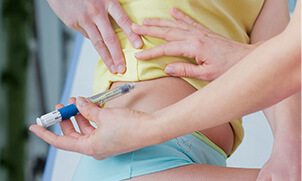Timed Intercourse
Towards reaching a dream, Become a parent.
Low complexity treatments
Procedures to achieve pregnancy.

Infertility Treatments in Mexico
IVF with high pregnancy rates in Mexico.
In Vitro Fertilization is recommended when previous treatments, such as artificial insemination, have failed; the procedure consists in the oocyte extraction with posterior fecundation with spermatozoids, once this procedure is performed, embryos are transferred to the mother’s uterus. This technique is performed in the In Vitro laboratories of Fertility Center Cancun.
IVF helps in both female and male infertility alone or combined.
How much does IVF cost in Mexico?

Intrauterine Insemination (IUI)
Assisting reproduction on couples with infertility issues.

Without ovarian stimulation:

With ovarian stimulation:
Some of the most common male infertility causes are:
Some of the most common causes of female infertility are:
To whom is this procedure aimed?
This In Vitro Fertilization procedure or IVF is indicated in the following cases:
- Women with limited oocyte number.
Fallopian tubes lack or injury.
When Artificial Insemination has failed.
Men with low sperm quality.
Low embryo quality with constant implantation failure.
Women with no partner.

Fertility center results
We are by far the most trained fertility clinic in Cancun, granting you a summed succeed rate of up to 95% per cycle. Our firmest purpose here at Fertility Center Cancun is for you to achieve your dream with the least financial and emotional wear, bringing you the most specialized attention.
Learn step by step for your first date. Click Here!
Who is candidate for this procedure?
Generally this procedure is the first proposal made to couples seeking to get pregnant and show some of the following:
- At least one healthy fallopian tube.
- Alterations in the uterine cervix.
- Coital difficulties in the woman.
- Slight endometriosis.
- Unknown infertility.
Advantage
The main advantage of this procedure of all that encompass the Assisted Reproductive Techniques, is the least invasive way, it’s simple, low cost and very similar to a natural conception, with the difference that on this procedure, the sperm is selected, adding a hormonal treatment for the woman where you know the exact time of ovulation, thus increasing exponentially the success rate for implantation.
Results
This basically depend on the age of the woman and the infertility cause, but in a general sense, there is the need to understand that the pregnancy rate with artificial insemination is accumulative, meaning that in the event the first attempt fails, the following attempts increase the chances of success, and successively, until a maximum of 4 to 6 cycles, getting all the way to 50 % of success rate.

How to achieve the best results?
Is important that before beginning this procedure is necessary to know the couple’s age and their general health state, for which they will be required to perform an evaluation through laboratory tests.
Requirements to become a candidate to this procedure:
- Women with age below 30 years old.
- Rule out any possible uterus malformations through an ultrasound.
- Rule out any possible pathology through an ultrasound.
- Haven’t previously realized any reproduction treatment.
- Normal semen.
- Fallopian tubes permeability.
Our Fertility Process

1. Ovarian stimulation.

2.Punction, retrieval and aspiration.

3. Fertilization through ICSI.

4. Embryo culture.

5. Embryo transfer.
When the embryo is at its best moment to implant on the woman’s uterus, is places inside the uterus on its distal locus (near the Fallopian tubes) to start its development and furthermore, to carry a pregnancy. This is performed by charging the embryos on a cannula that is conducted trans-vaginally until it reaches the uterus. An embryo or two may be transferred, according to each particular case.

6. Embryo vitrification.
Our Process

1. Ovarian stimulation and monitoring.

2. HGC application.

3. Semen collection and prepping.







